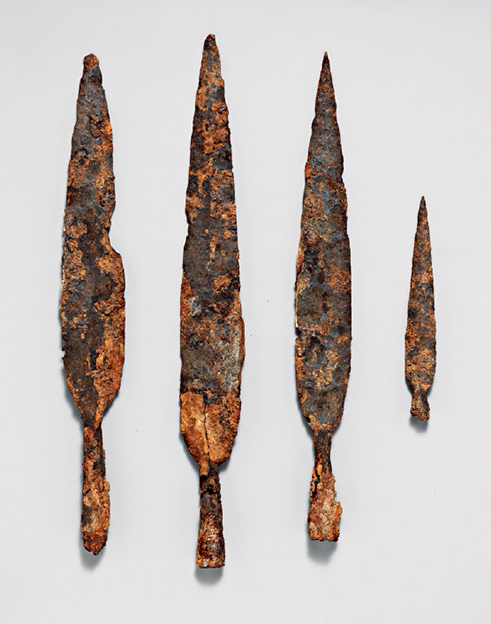c. 1200–500 BCE
The Iron Age
Anthropologists have labeled the most recent of the three societal and technological periods of prehistoric human history the Iron Age. The transition from the Bronze Age to the Iron Age is generally marked by the production of weapons and tools by ironworking, and most specifically by the widespread use of carbon steel. Smelting of ores to extract iron is much more difficult than extraction of copper and tin, requiring specialized higher-temperature furnaces and precise mixtures of various alloys designed to yield high strength and protection from rust. As such, the invention and widespread dispersal of steel weapons and tools, with superior hardness and durability compared to their bronze equivalents, gave a significant technological advantage to those who could make them.
The earliest forms of ironworking involved smelting of mixtures of iron ore and charcoal in furnaces that used bellows to force air into the mix. At high enough temperatures, the carbon in the charcoal helped to convert the iron oxides in the ore to a mixture of stony minerals (slag) and metallic iron, which could be further worked by hand to remove the slag and leave behind the wrought iron. Late Bronze Age ironworkers (smiths) discovered that further heating wrought iron on beds of charcoal, followed by rapid cooling or quenching of the melt, yielded an even harder and more durable alloy—steel.
Archaeological evidence supports the earliest occurrences of mass-produced steel tools and weapons around 1200 BCE in the ancient Near East (Mesopotamia, Egypt, Iran, the Arabian Peninsula, and surroundings). From there, steel-smelting technology appears to have spread into the Mediterranean and eventually into Asia and Europe; routine steel production in northern Europe appears to have started sometime around 500 BCE, marking the approximate end of the prehistoric period known as the Iron Age. Not coincidentally, this is around the same time that routine, reliable historic records about individual and global civilizations began to appear.
Significant advances in technology have enabled modern steel alloys to have far superior strength and durability compared to that produced by our ancestors. Indeed, some scholars have cited the proliferation of massive skyscrapers, bridges, and other steel structures since the Industrial Revolution as evidence for a New Iron Age.
SEE ALSO The Stone Age (c. 3.4 Million BCE TO 3300 BCE), The Bronze Age (c. 3300–1200 BCE), Industrial Revolution (c. 1830)
Four Etruscan iron spearheads from around 550 BCE.
